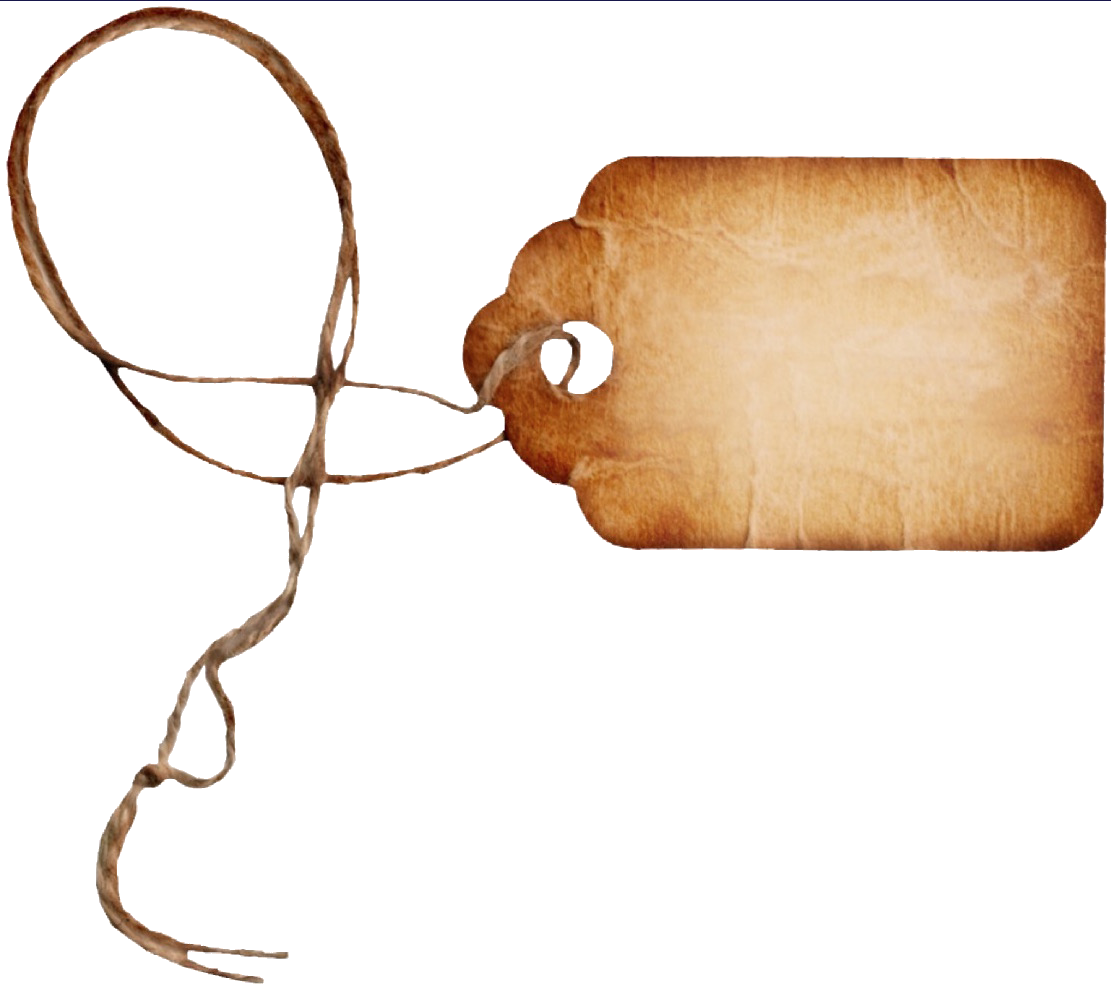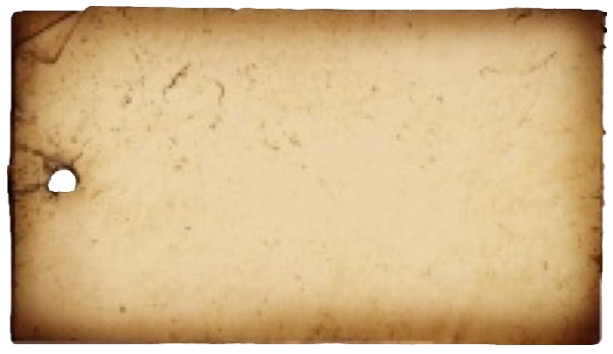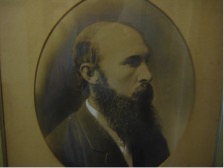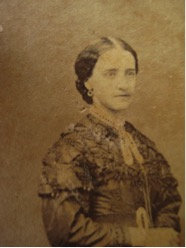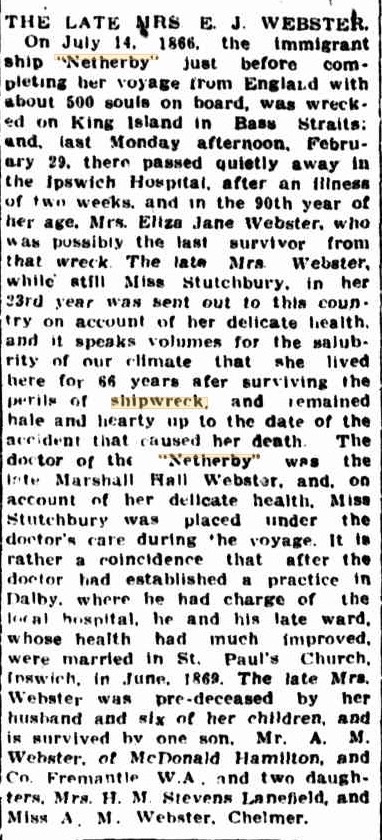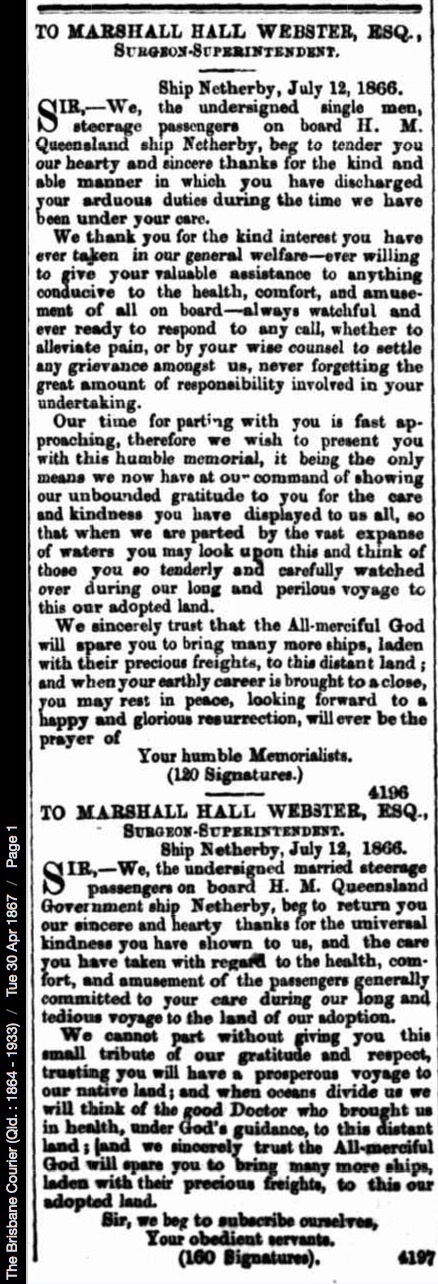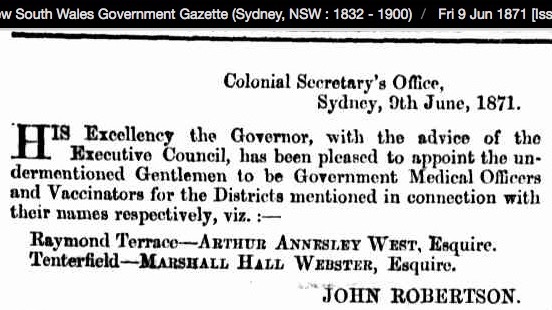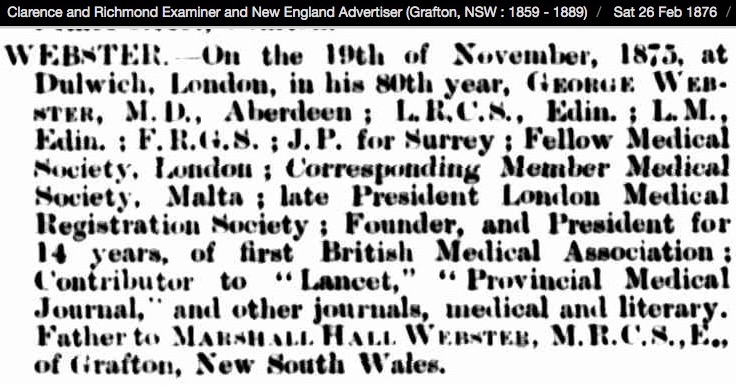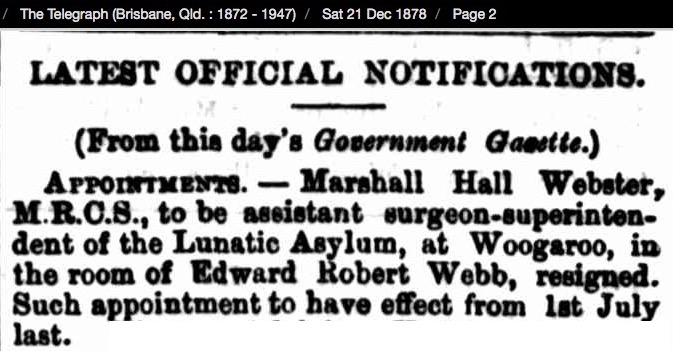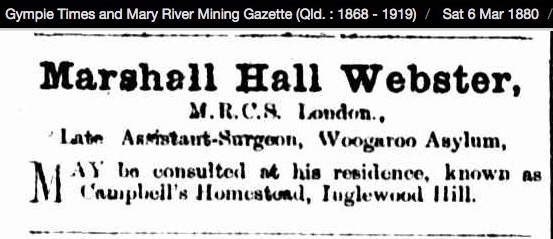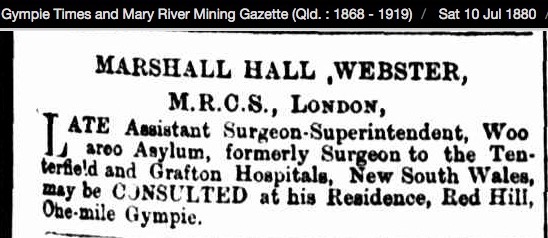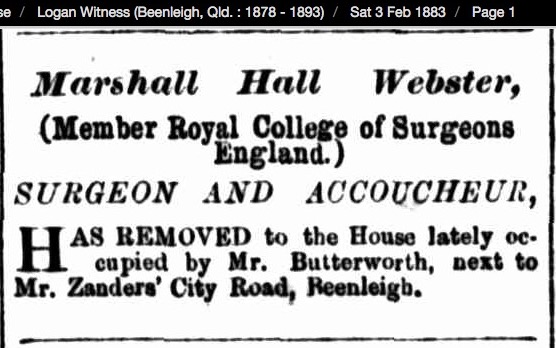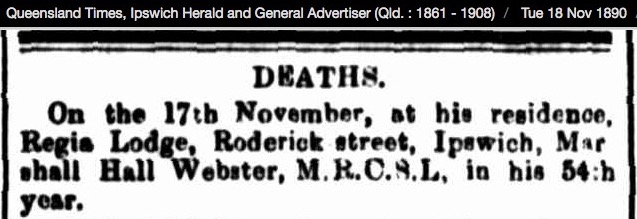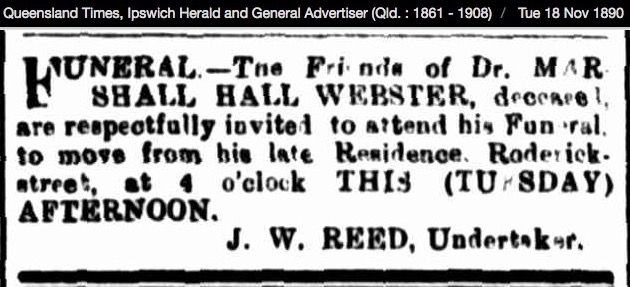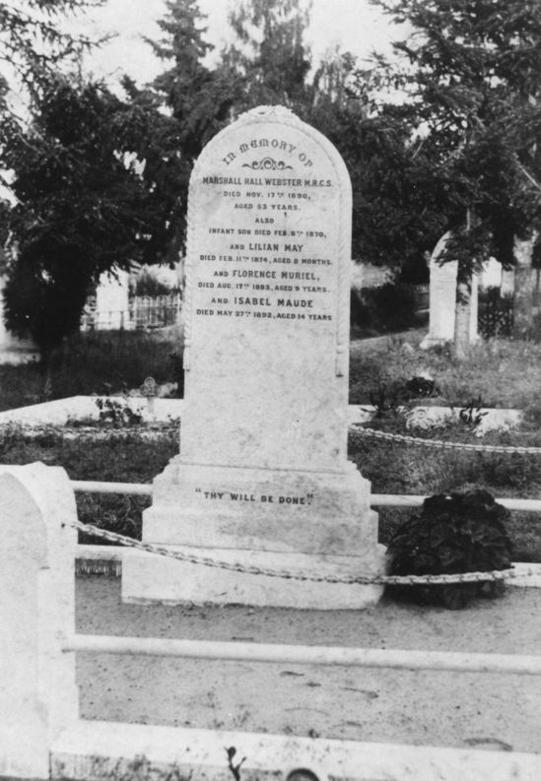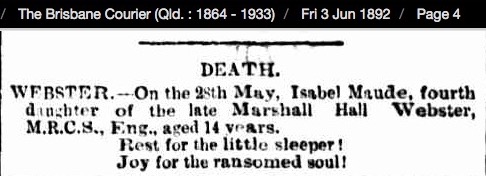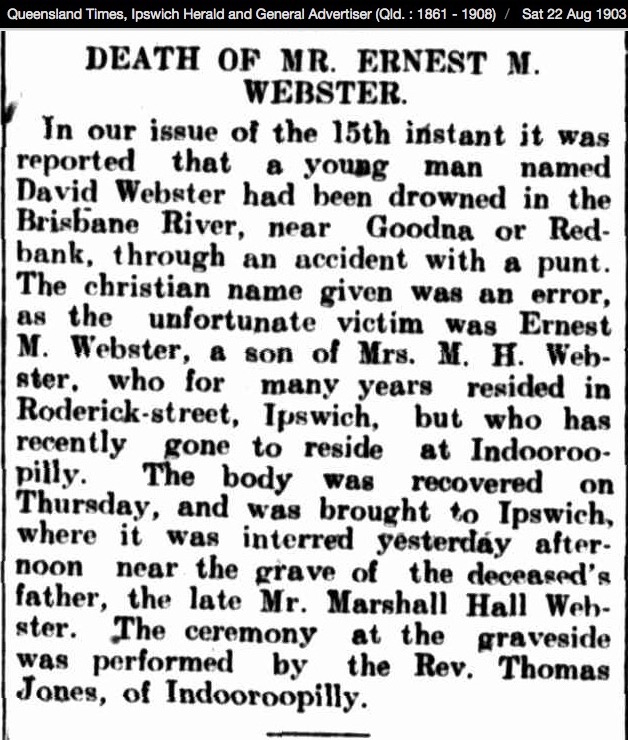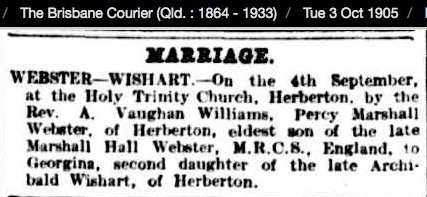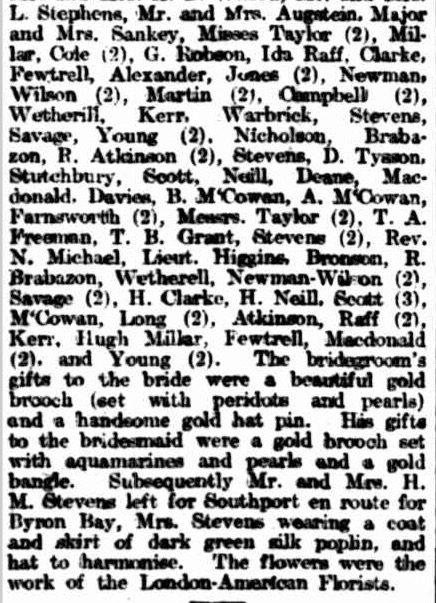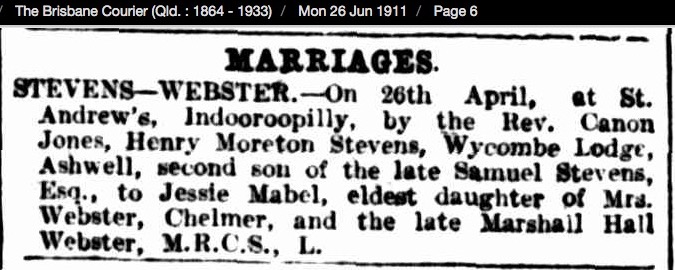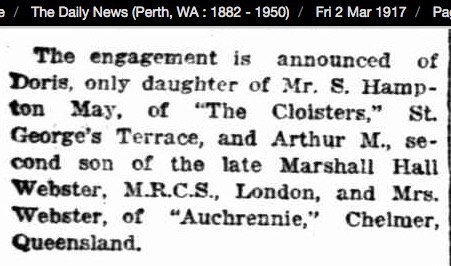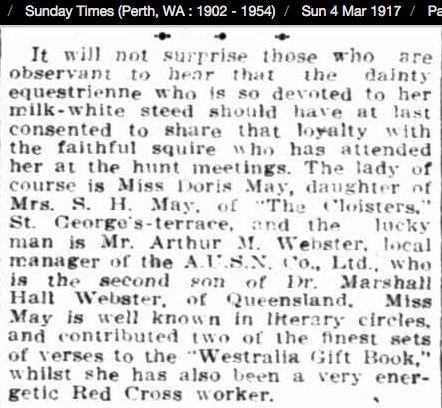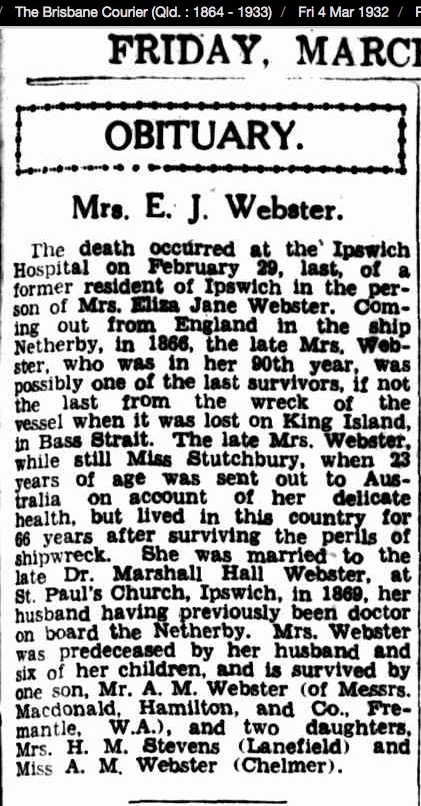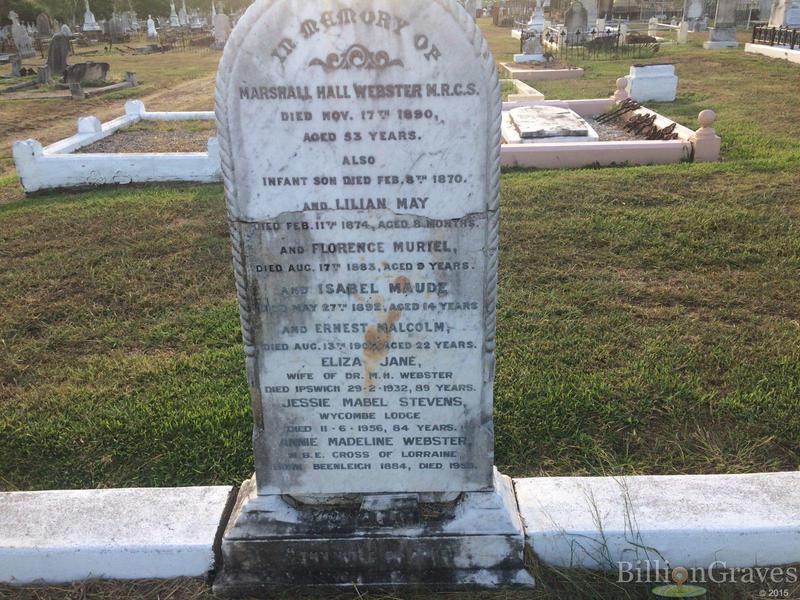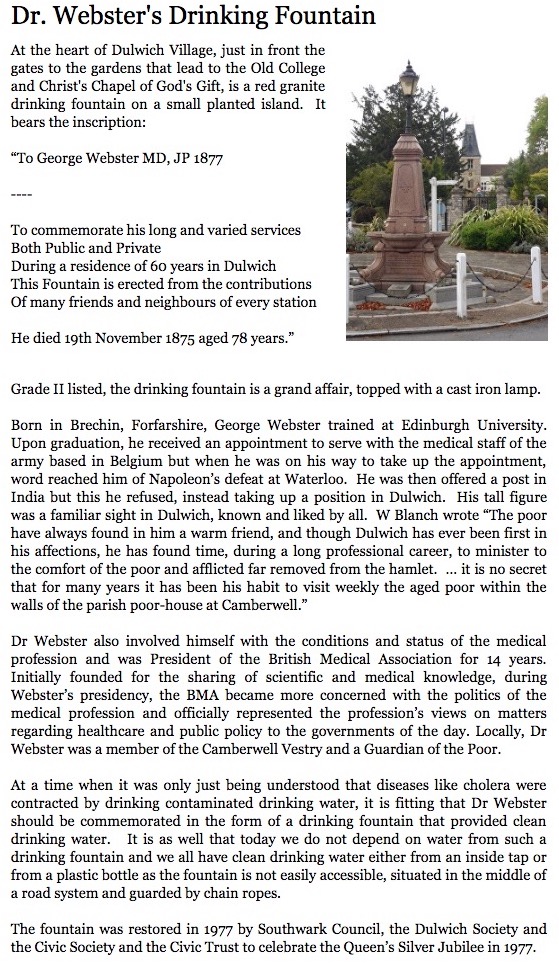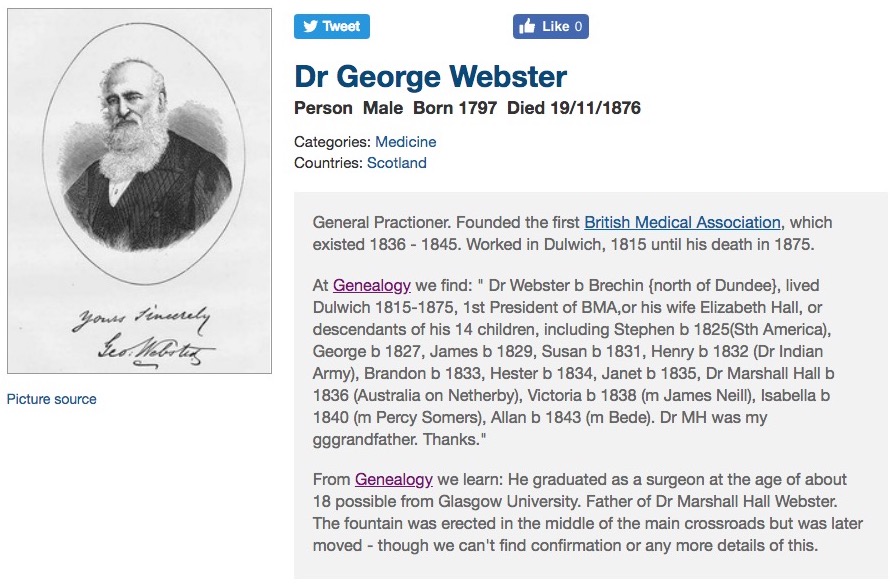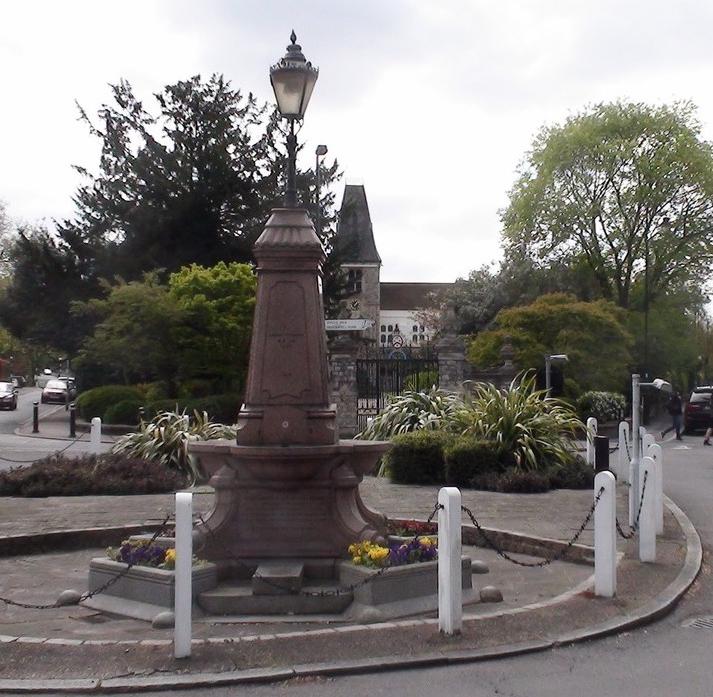Passengers stories
by their descendants.
Marshall Hall Webster
Ships surgeon superintendent
and wife to be
Eliza Jane Stutchbury
The story of: Marshall Hall Webster MRCS (Lond). Surgeon-Superintendent on the “Netherby”, 1866 & Eliza Jane Stutchbury
Marshall Hall Webster was born and grew up in Dulwich, then a small attractive hamlet to the south of London. Marshall and at least one of his brothers attended school in St Andrews, Scotland for a time, suggesting that father George had planned for them to go on to Edinburgh University, which certainly at George’s time offered the best medical training in Britain, attracting students from as far as the United States.
However by the time Marshall entered his medical training St Thomas’ Hospital Medical School in London had acquired a very fine reputation, and Marshall graduated from there in 1861 at the age of 25, obtaining his MRCS St Thomas’ – a qualification very similar to an M.D.
He then worked for a time as house surgeon there. By at least 1863 however he was working as Ship’s Surgeon in charge of troop ships in the Mediterranean and to the West Indies, and he continued these trips to 1865. His first trip to Australia was to Melbourne in 1863 on the Yorkshire, followed by a trip early in 1864 as Surgeon Superintendent on the passenger ship Young Australia. He made a second trip to Australia on the same ship later in the following year.
However in 1866 Marshall Hall Webster, at the age of 29, left England for the last time, as Surgeon Superintendent on the passenger ship, the Netherby, bound for Brisbane, Australia. His account of the shipwreck can be found HERE.
Once in Melbourne another doctor took over the care of the passengers who were housed, apart from the Saloon passengers, in the Exhibition buildings. Marshall had time for a bath and a change of clothes before electing to return to the lighthouse to collect the 117 young men who had been sent there before the boats arrived from Melbourne, after the lighthouse keeper reported there was capacity there to shelter and feed them.
On reaching the lighthouse there was a stiff breeze and heavy surf which prevented the ship from approaching the shore, and it was forced to anchor some eighteen miles away. Messages from the lighthouse had indicated that many of the young men had got in only the previous day and were exhausted and footsore. Marshall Hall therefore himself walked the eighteen miles from the ship back to the lighthouse, arriving at dusk. Two days later he and the men left at 3.30am to walk back to the ship, arriving at 8am. All except two crew who still did not wish to leave for fear of not being paid had meanwhile been collected from the wreck site.
Despite the exposure in mid-winter to which the wreck survivors had been exposed, and the difficult time in the southern ocean, the overall health of the passengers on this voyage was extremely good. Only two small infants died on the voyage, both very ill when they came on board. Two other healthy babies were born on the voyage as well as the little girl on the beach after the wreck. Marshall had throughout the voyage been extremely exigent about cleanliness on board, with so many crowded in such small spaces. Of the 13 shipwrecks on King Is alone in the 19th century the Netherby was one of only 4 with no resulting loss of life – which was very high in some cases.
It seems that Dr Marshall Hall Webster was a major reason for these good outcomes, through his excellent management on board, his knowledge of dietary requirements, his medical and surgical skills, his very high level of commitment to those in his charge, and his ability to calm all after the ship foundered, when panic could so easily have resulted in a high loss of life.
His talents and knowledge are further reflected in his weekly contributions to the ship’s publication – the Netherby Gazette – where he wrote poems, one entitled A Funeral at Sea, movingly describing the burial of one of the infants who died on the voyage; provided positive advice “I shall be happy to assist you in any way during our voyage.....It has always been my endeavour to prove that even a voyage across the dreadful ocean can be made pleasant and agreeable......the great secret of being happy is to make ourselves contented, cheerful, kind, and obliging to each other...”; gave information about the progress of the ship and the health of the passengers; and wrote articles about health, including two on the dangers of smoking, including the damage to the heart and lungs which could ensue – showing him to be remarkably ahead of his time in medical knowledge!
One of the possessions which Marshall saved from the wreck and which was presented to its owner by Capt Owens was a very large leather-bound family bible belonging to one of the Saloon passengers.
In it Marshall later wrote:
Saved from the wreck of the “Netherby” on King Island Basses Straits, Coast of Australia, July 14th 1866; on which occasion nearly 500 lives were preserved from an untimely death.
“When thou passest through the waters, I will be with thee; and through the rivers, they shalt not flow over thee; when thou walkest through the fire, thou shalt not be burnt, neither shall the flame kindle upon thee.”Isaiah XLIII v2
On the 30th July, a little over two weeks after the shipwreck, those passengers who still wished to proceed to Brisbane, accompanied by Dr Marshall Hall Webster, boarded the City of Melbourne for that voyage.
Although one assumes he would normally have discharged his duty to the Netherby passengers upon reaching Brisbane, their original destination, and returned on some other ship of the Black Ball line to England, Marshall in fact was never to return to his country of birth.
On the ship he had met the twenty-three year old Eliza Jane Stutchbury (1842-1932), a Saloon class passenger – and owner of the afore-mentioned bible - who was travelling out alone to Ipswich, Queensland, to join her mother, Maria Susannah Smith, nee Taylor (1817-1888) who after the death of her first husband George Thomas Stutchbury (1809-1848), a shipping agent in London, had married the Honourable R. J. Smith, (1819-1883), a retired Member of the Legislative Council of Queensland and subsequently Mayor of Ipswich and Commissioner for Crown Lands.
By 1866 Maria had been in Australia for some time, at least from 1847 - just prior to her husband’s early death in 1848 from causes unrelated to her departure. Maria had married at 18 and had had 5 children, of whom Eliza Jane was the youngest, and only 6 years old when her father died. The young Eliza Jane had subsequently lived with relatives in London, and then attended finishing school in Switzerland before making the voyage to Australia on the Netherby. Here it seems a mutual attraction developed between her and the very appealing Dr Marshall Hall Webster.
A family story relates how excited Maria was upon seeing the Surgeon Superintendent in his carriage passing her hotel in George Street, Brisbane, on his way to present himself to the Governor.
For his part, rather than returning home, Marshall decided to stay in the Colony; working as a doctor first in Tambo and then Dalby, both in Queensland. In Dalby he also received an appointment as a Magistrate of the Territory of Queensland in January, 1869.
On the 24th June 1869, almost three years after their voyage from England, Dr Marshall Hall Webster and Miss Eliza Jane Stutchbury were married in St Paul’s Church, Ipswich. The gates of Queen’s Park were opened so they could drive in their carriage through the Park. Dr Webster, aged thirty two, is listed as Surgeon on the marriage certificate and Eliza Jane, twenty-five, as “Lady”. A notebook given by Marshall to his bride is inscribed “To Lizzie, with her husband’s love.”
The couple lived first in Dalby where sadly the following year their first son, unnamed, was stillborn. He was buried in Ipswich Cemetery.
By 1871 they had moved to Tenterfield, New South Wales, where Marshall had been appointed Surgeon to the Hospital; and where their eldest daughter, Jessie Mabel (1871 – 1956) was born on the 15th July, her father the accoucher. Two more girls were born here – Lilian May, on the 26th May, 1873, who very sadly died eight months later in February 1874; and Florence Muriel, born on the 24th September of the same year – who was also to die tragically early at the age of eight in 1883.
The Websters had made the move to Grafton, NSW by the end of that year. Here Marshall Hall was a Church Warden in addition to his medical duties. Percy Marshall (1876 – 1920) was born here in February 1876.
However by late in the following year the family had again moved, this time to near Ipswich, where Dr Webster took up the position as Assistant Medical Superintendent at Woogaroo Lunatic Asylum, Goodna – now The Park, Centre for Mental Health. Undoubtedly the main reason for the move would have been Eliza’s wish to be closer to her mother, however it is of note that there seems to have been an interest amongst doctors in the Webster family in the well-being of the mentally ill: we know that his father George visited asylums in France seeking a model for best practice in this area, and that he had a publication in the Lancet appealing against the incarceration of “harmless lunatics”.
Perhaps because of her own unsettled life when young, Eliza seems to have been unable to be happy in one place. One also tends to wonder about her parenting skills, having also missed out on this modelling as a child herself. Despite being now closer to Ipswich, the next child Isabel Maude (1878-1982) was actually born in Balmain, Sydney, at the end of March, only a few months after the Websters had moved. Most likely Eliza’s mother accompanied her to Sydney where they probably stayed with Eliza’s brother Thomas James Stutchbury (1837-1890), who had married in Sydney in 1861 and set up a successful business there. However the next boy, Arthur Montague (1878-1949), was born at Woogaroo three days after Christmas in the following year.
A year later in November 1879 Marshall Webster resigned from his position at the Asylum. It appears he may have made a complaint against his superior the Superintendent, as he was a witness in a case involving charges against the latter. It is easy to understand that Dr Webster, possessed of knowledge of contemporary best practice in the care of the mentally ill, might have found a discrepancy between particularly his father’s informed and enlightened views and those influencing practice in Queensland at that time.
The family’s next move, in 1880, was to Red Hill, One Mile, Gympie. Gold had been discovered there in 1867, leading to a rush of prospectors by the following year and the beginnings of the town named Gympie. By the early 1880’s the One Mile area, the focus of much of the prospecting, possessed many substantial buildings including churches and a hospital. It seems that here Marshall launched into private practice for the first time, as opposed to working as a Government Medical Officer, as we find a newspaper advertisement in August 1880 stating “Marshall Hall Webster M.R.C.S. London, lately Assistant Superintendent Goodna, formerly Surgeon to the Tenterfield and Grafton Hospitals, may be consulted at his residence.”
The couple’s youngest son, Ernest Malcolm (1881-1903) was born here the following year. He was to die tragically at the age of twenty-two in a boating accident in the Brisbane River just upstream of the family’s home at the time on the river bank at Chelmer, Brisbane.
A year later the family in 1882 had again moved, this time to Beenleigh, closer to Ipswich, where again Dr Webster appears to have conducted a private practice. Beenleigh was the centre of a rich agricultural district, with sugar cane crops and distilleries, on the main road from Brisbane to the Tweed River settlements, and in 1876 was described in Balliere’s Queensland Gazetter as “fairly ranked as one of the most thriving places in the colony.”
Sadness again struck the family here, with the death of Florence Muriel, age eight, from inflammation of the lungs, on the 17th August 1883. Florence was buried in Beenleigh, her name inscribed on the family tombstone in Ipswich Cemetery.
The last child, Annie Madeline (1884-1961) was born in Beenleigh on the 27th March the following year. She never married, and if she had been a boy it seems most likely that she would have followed in her father’s footsteps as a doctor. As a woman at that time, she worked tirelessly for the Red Cross, ministering to returned soldiers in the tuberculosis wards in Brisbane Hospitals until her own death at the age of seventy-seven from the same disease. Her work was recognised with a Cross of Lorraine and M.B.E. – the latter presented by Queen Elizabeth herself during a Royal Visit to Queensland. Her name is also recorded of the Shrine of the Order of the British Empire in St Paul’s Cathedral, London.
The final tragedy struck whilst the family were in Beenleigh, when as family history relates Dr Webster was thrown from his carriage when his horse was frightened by lightening whilst he was going out to visit a patient at night in a storm: he lay in the cold rain all night before being rescued, and in consequence suffered very poor health from then on. He never practised again.
On the 17th November, 1890, after five years of very reduced health, Dr Marshall Hall Webster died suddenly of a stroke at the family home Regia Lodge, aged only fifty-three. His obituary in the Ipswich Herald follows:
At about 4 o’clock yesterday afternoon, a very respected resident of the town, in the person of Dr Marshall Hall Webster, MRCS, London, passed away at his residence, Regia Lodge, Roderick Street. The deceased gentleman had been ailing for some years back, and had been attended by Dr Lightoller for some considerable time, but the end was somewhat sudden, and was caused by congestion of the brain. Dr Webster was the son of Mr George Webster, MD, of Dulwich, England, and was named after the celebrated Dr Marshall Hall, of London, who was a very old friend of his father.
The deceased was a colonist of some standing, having come out to Australia about twenty three years ago, and had spent a good portion of that time in this colony, being a resident of Ipswich for the last six years. In the earlier days he was Government Medical Superintendent in the Immigration Service, and also occupied the position of Assistant Medical Superintendent at the Asylum for the Insane, at Goodna.
Of late his failing health compelled him to lead a very retired life, but, nevertheless, he had made many friends in this town who will be sorry to hear of his demise. A wife and six children are left to mourn the loss of a loved husband and revered parent.
A tragic end to a life so full of promise. As he had done all his life, Marshall Webster had put his concern for his patient before his own well-being, and had paid the ultimate price.
Of the nine children born to Dr and Mrs Webster only three lived to normal old age – Jessie Mabel, Arthur Montague and Annie Madeline; and only the first two have descendants today. All three however were a tribute to their father, as was a further son Percy Marshall, who lived to the age of 44, married and had three children who also tragically died when very young, before their father.
Story and photos provided by great granddaughter Penelope Webster Svensson.
News articles and notices sourced from Trove, headstone photos from Graves Index, photos of father George's fountain from Google images: by site admin Karina.
Marshall and Eliza
3 March 1932 Queensland Times
Death Notice
From State Library QLD. Out of copyright
Ipswich General Anglican Cemetery, family plot.
Record of burials in the Webster family plot in Ipswich Anglican General Cemetery.
Marshall Hall Webster's father George
